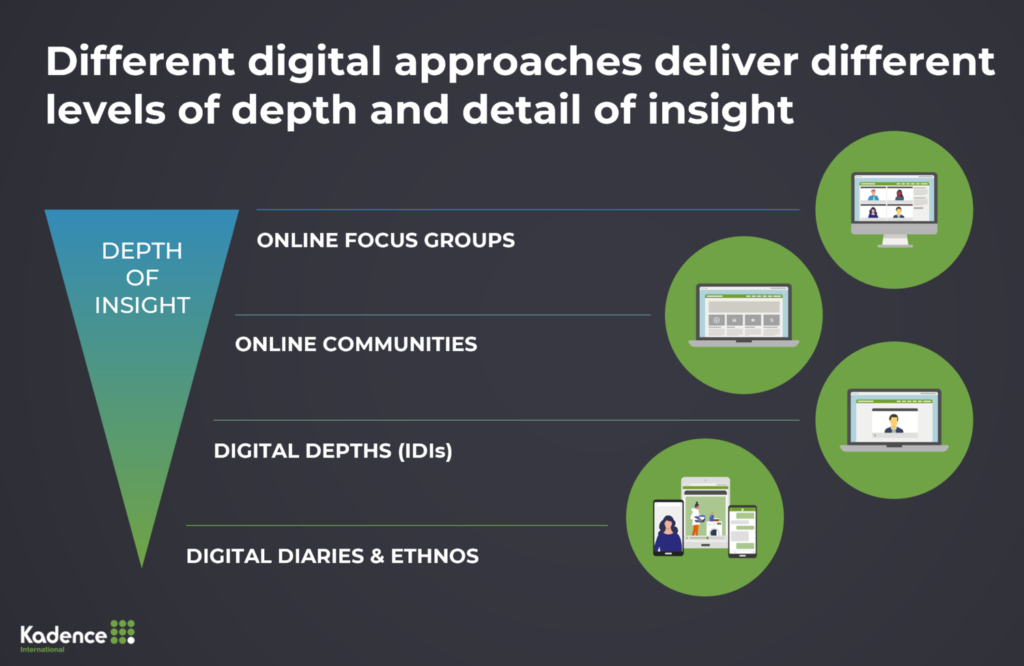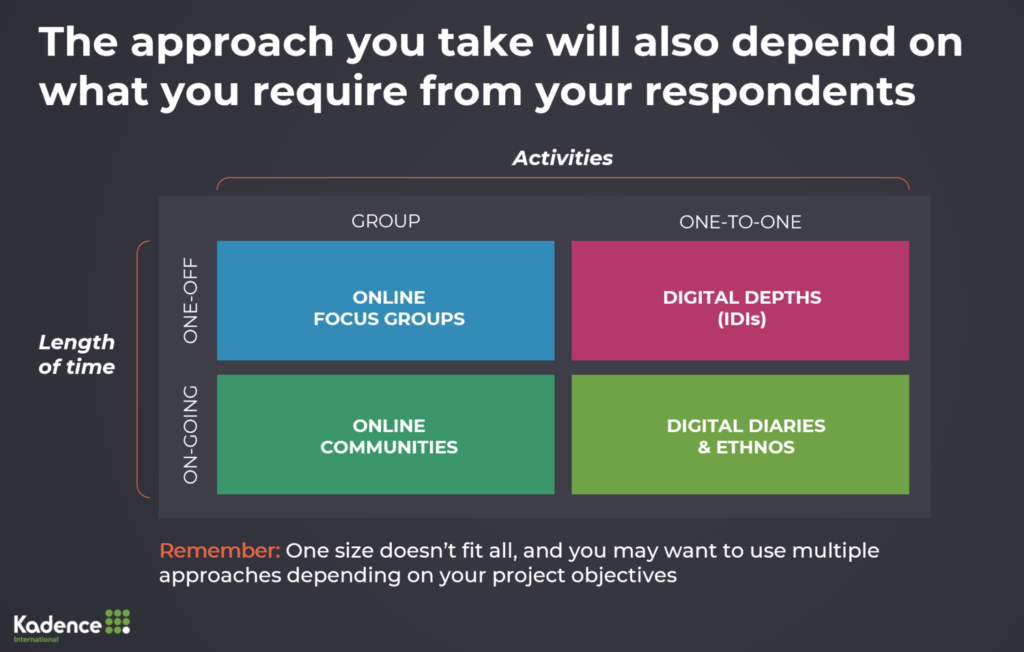As opportunities for face-to-face research become more limited in the current climate, online research is coming to the fore. To help our clients navigate this shift, we ran an Ask Us Anything session to give clients a chance to ask their questions on getting the most out of online research. Almost 200 of you joined us, but for those that missed the session, we’re sharing the top 10 questions asked in the session, along with our expert advice.
1. Should I be doing research during the COVID-19 crisis?
As a result of the current crisis, we are seeing dramatic shifts in behaviours and attitudes. There’s a tendency to think that this will soon pass and that life will return to “normal”, but the reality is that consumers are going to be adjusting to a new normal. As insight professionals it’s our job to understand the changes we’re seeing so we can advise our clients on how to react accordingly. Arguably, research is now more important than ever before.
What’s more, in some ways, the lockdown situation will actually allow us to delve even deeper into the consumer psyche to understand emotions. One of the age-old techniques we use in qualitative research is the deprivation question, where we ask people to imagine what they would do if a product or service wasn’t available to them anymore. The truth is that this is now a reality for many consumers, and as a result, they’re able to consider and eloquently discuss the role products and services play in their lives in much more detail than before. Added to this, many B2C and B2B respondents now have more time on their hands, meaning that recruitment is actually easier, and we’re seeing greater engagement in the research itself.
2. How do we ensure that current emotions due to the COVID-19 crisis do not affect the way consumers answer?
We can’t ignore the crisis and the impact it’s having on consumers and businesses alike. As a result of what’s happening, people are re-evaluating what’s important to them and the relationship they have with brands. Their expectation of brands and the role they should play is changing. A classic example of this are the many brands like Brewdog and LVMH that have ramped up their processing lines to produce hand sanitiser for health services. As brands pivot and change their approaches, consumers are naturally going to change their views of those brands. It’s vital to be able to tap into these emotions to understand the expectations that consumers have of brands now and in the future.
3. I usually do focus groups. What should I do now?
Instead of thinking about the methodology you had initially planned to use and how you might replicate this online, take a step back. Return to your project objectives and what you’re trying to achieve.
We see too many clients trying to find a like-for-like replacement when they’re considering online methodologies. If they’re used to running focus groups, some automatically default to an online focus group, but in reality, it could be that another methodology is better suited to their project objectives.
We use two frameworks to help clients think about moving their projects online. The first is to consider the depth of insight you need to obtain. If you’re looking for high level responses to concepts it could be that an online focus group will suffice, but if you really want to drill into who your consumers are and how they engage with your product, digital depths or ethnos could be more suitable.

We also encourage clients to think about what they’re looking for from their respondents. Do you want to engage respondents on a one-off or on-going basis? Do you want your respondents to bounce ideas off one another, or is a one-to-one setting more appropriate?

These simple questions can be really useful in helping you think about the right methodology, but remember, one size doesn’t fit all. It is likely that you’ll want to use a combination of methodologies to achieve your objectives.
4. My budgets are being cut. How do I ensure that I get the most out of my investment in online research?
An online approach is incredibly asset-rich. It will give you a host of video, image and text-based content, sometimes giving you more bang for your buck than some offline methodologies. But to get the most out of your investment you need to think about two key things: moderation and analysis.
For online communities in particular, this is crucial not only to curate the conversation but to help you unearth those nuggets of insight. By moderating and analysing what’s coming out of the community on an ongoing basis, you’re able to dig into areas of interest that emerge during the course of the research and ask new questions as you go to help answer your objectives. This ensures you leave no path unexplored throughout your research.
At the same time, with such an enormous amount of information coming out of online methodologies, you need structure in your analysis to ensure you can build your insights appropriately. We have a range of tools we use in-house to help structure our analysis and thinking, focused on delivering the ‘so what’ to our clients and their stakeholders.
5. How can I balance a tight budget with the need to conduct qualitative research that is more representative of the market?
In this instance we’d recommend an online community approach. If you opt for a less complex and therefore more cost-effective platform, you can invest your budget in a larger, more representative sample. Keep tasks at a high level to ensure the analysis is manageable and consider using polling questions to give you broad-based findings at a quantitative level (sample sizes permitting!)
The one challenge that can come with increasing the size of your community is in being able to build rapport with and amongst respondents. To overcome this think about grouping people so that they can discuss topics in smaller groups within the community (e.g. customers vs. non-customers).
6. What are your top tips for moderating an online focus group?
Firstly, make sure you choose the right platform for your project. There are a range of platforms out there and they all have different functionalities that are suited to different business objectives. Depending on your market, you may choose to go with a text-based approach rather than video, if internet connections are slow.
Whichever one you choose, make sure it’s one that will allow you to see all the respondents’ faces on screen at one time, so that you can read facial cues. To help with this, keep your groups small – we’d recommend a maximum of 6 – 8 respondents.
Get regular insights
Keep up to date with the latest insights from our research as well as all our company news in our free monthly newsletter.

Don’t forget that you can use pre-tasks and warm up activities to better understand your respondents and build rapport. Make sure your moderator does their homework upfront, reviewing the screener and learning as much about each respondent before the session begins. Once you’ve done this the medium will soon become secondary as respondents relax into the group. Keep tasks varied within the discussion guide to keep everyone engaged, and finally, as with offline focus groups, the moderator’s energy is crucial, so choose wisely!
7. How can I use online methodologies for concept testing? How does this work with highly confidential concepts?
Online methodologies are a great tool for concept testing – and arguably can provide an even greater depth of insight to inform product development.
Online communities in particular are a great tool for this. Many platforms are specifically built with concept testing in mind and have tools that allow respondents to mark up elements of a concept that they like or dislike, along with a justification. The responses you get here can be even more detailed than in a face-to-face group.
Communities also allow us to iteratively improve the concepts over time. We can rapidly adapt concepts based on consumer feedback and put them back into the community for further comment, allowing us to build and refine the concepts as the research progresses.
The community platforms we use also have in-built features for dealing with highly confidential concepts. Images can be watermarked with a unique respondent identifier and if you’re testing ads, we can set videos to self-destruct after they’ve been watched once. On top of this, we use all the confidentiality procedures we would for concept testing in-person. With such stringent processes in place, we’ve never seen a leak in over a decade of running this kind of research.
8. Is there a risk of “groupthink” when you bring people together for online research in groups?
There’s a common misconception that online communities only allow you to discuss things as a group. In actual fact, that isn’t the case. There are options to ask questions or set tasks that are completed privately, meaning that respondents aren’t influenced by others in the community.
9. Do online approaches work in Asia?
Absolutely. The key thing is to find a partner who understands the cultural and digital footprint of the market you’re researching, so that they can advise you on the best methodology to use, based on the respondents you’re wanting to reach.
Digital footprints and internet connectivity does vary from market to market, and within different regions of the same country, but it’s hard to deny the increasing impact of digital and mobile technology across Asia. In The Philippines, the social media capital of the world, video-based tasks could be a great way of conducting research, whereas in China, familiarity with the digital way of engagement – from online communities to Wechat groups – presents an opportunity to engage and reach out to your consumers where they already are. And even in more rural areas you can explore potential probable solutions, such as text-based solutions to communicate with those you want to reach.
The key is to decide whether digital research is the right solution for your research is to understand from your research partner the digital feasibility, connectivity and savviness of your target segments and locations.
10. I’m wary that with online mythologies I’m too far removed from respondents. I can’t see “the white of the eyes”. How do I overcome this?
We’d argue that online methodologies can actually help you get closer to consumers than you might in some face-to face approaches like focus groups. Particularly when we’re running an online community, we’re engaging with consumers over a number of days or weeks (rather than a few hours) and in this time we can really build rapport and trust. This results in consumers opening up to us, helped by the ease of talking about their experiences to camera. Often consumers are actually more willing to open up at a personal level when talking to their camera phone than to a person that they’ve only just met!
In fact, we’ve just run a community in the US, looking at how consumers are coping in the pandemic, and we found people pouring their hearts out to us via selfie interviews. This helped us to really understand the issues that matter to them, and the context of those emotions.
If you’ve like to learn more about how online research can help you meet your objectives, please get in touch with your local Kadence office.



 Senior Marketing Executive
Senior Marketing Executive Sales & Marketing
Sales & Marketing General Manager PR -Internal Communications & Government Affairs
General Manager PR -Internal Communications & Government Affairs Vital Strategies
Vital Strategies
 Customer Intelligence Director
Customer Intelligence Director